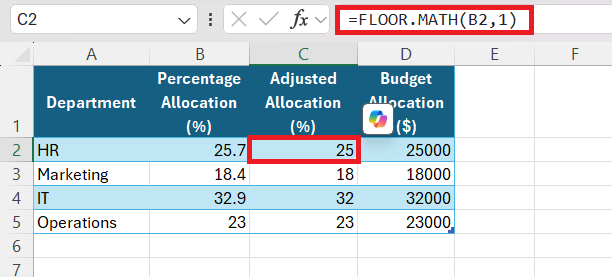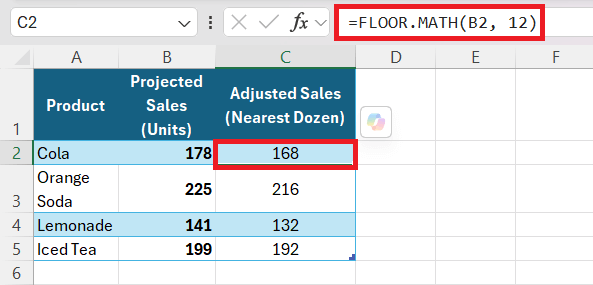In Excel, we often find ourselves working with numbers that need to be rounded in a specific way, either up or down, to fit particular requirements. One of the most helpful functions for rounding numbers down is the FLOOR function. In this article, I will guide you through what the FLOOR function is, how it works, and some real-world examples of how I use it to make my Excel tasks easier.
Key Takeaways:
- The FLOOR.MATH function rounds numbers down to the nearest specified multiple, offering precision in data analysis.
- It simplifies rounding in datasets, ensuring consistency in calculations for accounting, reporting, and inventory management.
- FLOOR.MATH can handle negative numbers, with an optional mode argument to control rounding behavior.
- It’s useful for practical applications like budgeting, sales forecasting, and reducing data discrepancies.
- Combining FLOOR.MATH with other functions, like SUMPRODUCT, helps maintain accuracy and avoid errors in complex calculations.
Table of Contents
Introduction to FLOOR.MATH in Excel
Understanding the Basics of FLOOR.MATH
When working with numbers in Excel, I often need to round values down to the nearest multiple of a given number. That’s where the FLOOR.MATH function comes in handy. It ensures precision by rounding numbers downward based on a specified significance level.
Syntax of FLOOR.MATH
The formula follows this structure:
- number – The value I want to round down.
- significance (optional) – The multiple to which I want to round. If omitted, Excel defaults to 1, meaning it rounds to the nearest whole number.
- mode (optional) – A value that affects how negative numbers are handled.
How FLOOR.MATH Enhances Data Analysis
Rounding Down to Whole Numbers with FLOOR.MATH
When I need to simplify a dataset, FLOOR.MATH makes it easy by rounding numbers down to the nearest whole number or specified multiple. This is especially useful in scenarios like accounting, construction measurements, or preparing data for statistical analysis. By removing decimals and rounding down, I can ensure consistency in my numbers, making comparisons and evaluations much clearer.
For example, if I have a measurement of 12.8 and need to round it down to the nearest whole number, I can use:
This returns 12, making my dataset cleaner and easier to work with.
Handling Large Datasets with Precision
When working with complex datasets, precision is key. Whether I’m handling financial reports or transaction data, FLOOR.MATH helps me apply consistent rounding rules effortlessly.
For instance, if I need to round down transaction amounts to the nearest 100 for reporting purposes, I’d use:
This returns 700, ensuring my reports align with accounting standards and avoid rounding up incorrectly. In large datasets, this automation reduces errors and maintains data accuracy without requiring manual adjustments. By leveraging FLOOR.MATH, I can ensure my numbers are precise, structured, and easy to analyze, making data-driven decisions much more reliable.
Practical Applications of FLOOR.MATH in Business
Example 1: Budget Allocation Made Simple
When I’m preparing a budget, I need to allocate percentages to different departments while ensuring that the total doesn’t exceed the available funds. FLOOR.MATH helps me round down each department’s allocation, preventing accidental overspending.
For example, if cell B2 contains a calculated percentage, I can use:
This rounds the value in B2 down to the nearest whole number, ensuring that every department gets a structured and controlled share of the budget. This is particularly useful when I want to avoid rounding up, which could result in exceeding the total budget allocation. By implementing this method, I maintain a transparent, organized, and accurate budgeting process.
Example 2: More Accurate Sales Forecasting
In sales forecasting, I need to ensure that my projections align with actual product packaging and sales trends. If my products are sold in cases of 12, rounding sales forecasts to the nearest dozen helps in better inventory planning and order management.
For instance, if B2 contains my projected sales figure, I use:
This rounds the number down to the nearest multiple of 12, ensuring my forecasts match actual sales patterns. If my projection in B2 is 178, this formula rounds it down to 168, which is the closest full dozen.
By doing this, I prevent overproduction, reduce waste, and optimize stock levels, ensuring that my inventory meets demand without unnecessary surplus. This simple step enhances efficiency and helps me avoid financial losses due to miscalculated stock levels.
Addressing Common Errors When Mixing Functions
Addressing common errors when mixing functions, particularly with FLOOR.MATH, can save us from headaches and calculation mishaps. One of the key issues is ensuring that the data types being fed into the combined functions are compatible and free from discrepancies. For instance, when I nest FLOOR.MATH inside a SUMPRODUCT function, I must ensure that the arrays being summed are purely numeric. Additionally, when dealing with functions that expect logical tests, such as IF statements combined with FLOOR.MATH, I always double-check that the conditions are clear and that the FLOOR.MATH function only operates on numbers that pass the test. By being vigilant about the compatibility and usage of combined functions, I significantly reduce the occurrence of errors and improve the reliability of my formulas.
FAQ
How to use floor math in Excel?
To use floor math in Excel, simply enter =FLOOR.MATH(number, [significance], [mode]) into a cell. Place the number you want to round down in place of number, optionally specify the significance to round to, and use mode to determine the direction for negative numbers. The function rounds down to the nearest integer by default. It’s a straightforward process that enhances the precision of your data with minimal effort.
How does the floor function work?
The FLOOR function in Excel works by rounding a number down towards zero, to the nearest multiple of specified significance. Basically, if you give it a number and a significance, it finds the largest multiple of that significance that’s less than or equal to the number. If the number you’re rounding is already a multiple of the significance, it stays the same—no rounding necessary.
What is the Difference Between FLOOR.MATH and Other Rounding Functions?
The difference between FLOOR.MATH function and other rounding functions lies in its default behavior and treatment of negative numbers. FLOOR.MATH rounds down toward the nearest integer by default, its significance is optional and has a unique mode for rounding negatives. In contrast, functions like ROUND are more general, rounding to a specified number of decimal places based on standard rounding rules, and CEILING.MATH always rounds up. Each rounding function is tailored for specific scenarios, so choosing the right one ensures precise and intentional results.
How to Use FLOOR.MATH for Negative Numbers?
To use FLOOR.MATH for negative numbers, we can leverage the mode argument within the function. By default, FLOOR.MATH rounds negative numbers towards negative infinity. Should I desire to round towards zero, all I need to do is set the mode argument to 1. The function then reflects this logic and alters the direction specifically for negative numbers. It’s a handy feature that helps me align my data exactly how I need it in scenarios where negative figures are subject to different rounding rules.
Can FLOOR.MATH be Combined with Conditional Formatting?
Absolutely, FLOOR.MATH can be combined with conditional formatting to visually distinguish rounded numbers. By applying conditional formatting rules that link to the cells with FLOOR.MATH formulas, it’s easy to highlight or color-code those that have been rounded down. This is a powerful way to enhance data visualization and quicken analysis, especially in vast spreadsheets.
John Michaloudis is a former accountant and finance analyst at General Electric, a Microsoft MVP since 2020, an Amazon #1 bestselling author of 4 Microsoft Excel books and teacher of Microsoft Excel & Office over at his flagship MyExcelOnline Academy Online Course.











